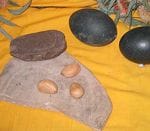The Kamilaroi are the second largest nation on the eastern coast of Australia, with Wiradjuri being the largest. Their nation covers 30,000 square miles of fertile soil, running rivers and streams. Their language is Gamilaraay and their lifestyle is to co-exist with, and maintain a balance with nature. Kamilaroi Aboriginal people lived in harmony with the environment.
The Kamilaroi believe in a large number of supernatural beings. Among them, the most important are: Baiame, Dharramulan and Garriya. Baiame, pronounced BYE-umme, is believed to have the greatest of Powers. Dharramulan is the one-legged son of Baiame. Legend says that Garriya, the Rainbow Serpent, a fabulous monster which appeared in a snake-like form, is now believed to be resting deep within Boobera Lagoon, 13.5km west of Boggabilla, NSW.
The Kamilaroi used kinship norms to regulate the behaviour of all people who had dealings with one another. This system of classes or skins governed everyday behaviour including marriage, ceremonies, camp layout, hunting parties and so forth. It brought with it a set of obligations that were performed when relating to others, and these obligations formed part of Aboriginal Lore/Law.
Totems handed down through the mother's line differentiate people into groups, for example ringtail possum (kurrawir), porcupine (bigibila), pademelon or wallaby (wang-uy), brown kangaroo (bundar), and so on. Totemism expanded across tribes, and a person with the same totem's are regarded as kin, regardless of what clan they belong to. A person's not allowed to marry their own totem, no matter how distant the connection.
The smaller clans mostly stayed within their own hunting area (taurai) but there were times when neighbouring groups came together for purposes such as settling disputes, marriages, trading, festivals, feasts, funerals and for help in bad times.
Messengers carrying message sticks (dhulu) were allowed to enter other sub-tribe's and tribe's lands to communicate with each group and would often let other tribes know where and when a ceremony would be held. A special, significant and respected ceremony known as the Bora (buurra) initiated boys into manhood. Other ceremonies that have religious connotations or are simply attended for entertainment are known as 'corroborees'.
Today, descendants of the traditional people of the Kamilaroi Nation continue to occupy these lands. They are known as 'Murri' people.
Enquire with the team at the Dhiiyaan Aboriginal Centre and Tourism Moree for information on our local Indigenous Arts, Art Galleries & local Significant Sites including Berrigal Creek, Boobera Lagoon, Northcote Bora Ring, Myall Creek Memorial & Terry Hie Hie Aboriginal Area (please check before entering these sites & please do not touch or remove any items or artefacts out of respect).








